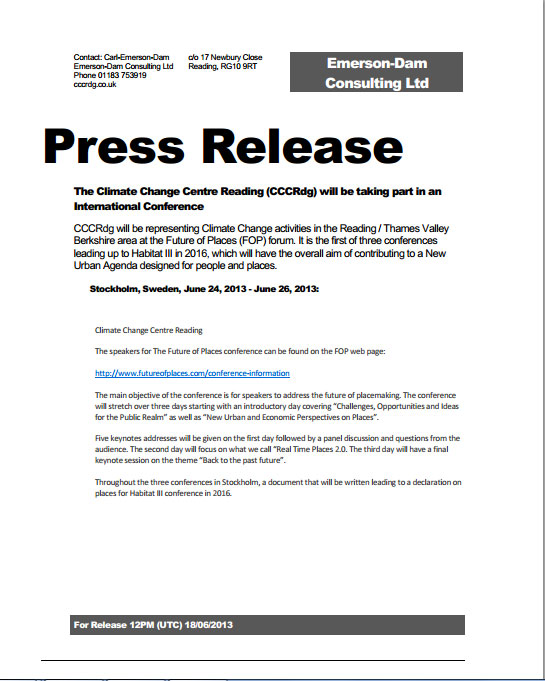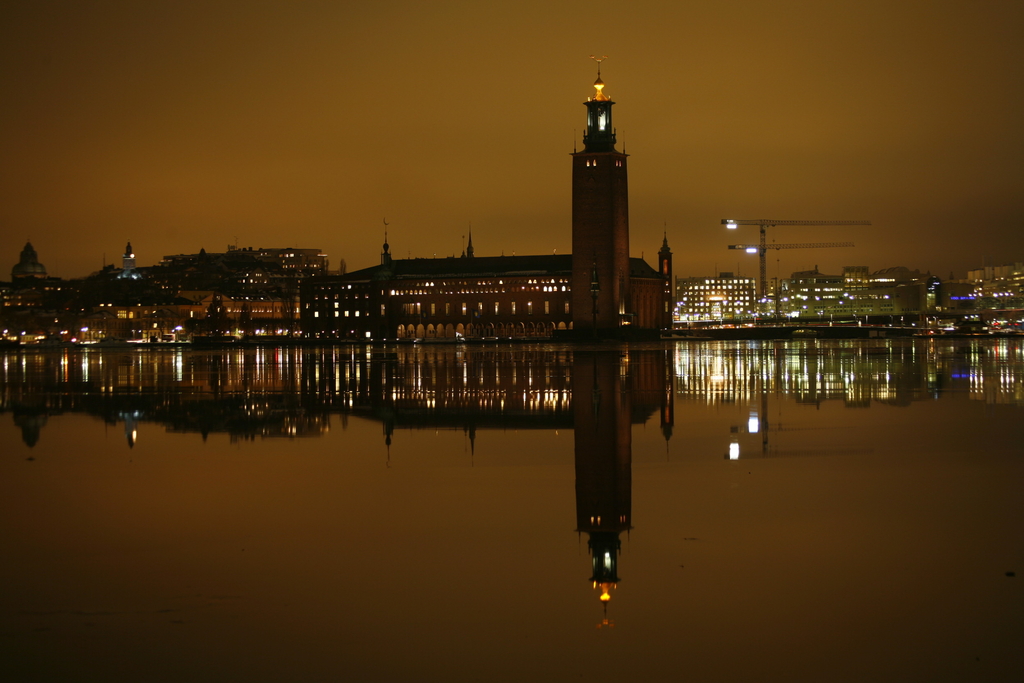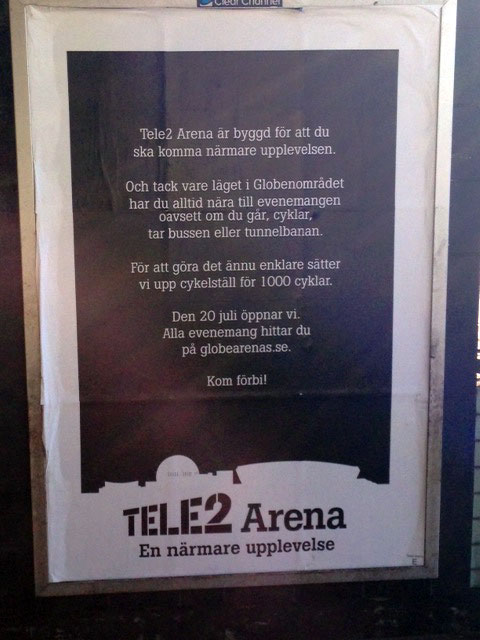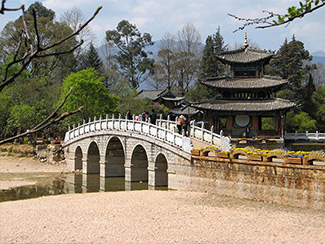Tag: Reading Borough Council
CCCRdg will be representing Climate Change activities in the Reading / Thames Valley Berkshire area at the Future of Places (FOP) forum
Newsdesk
Climate Change Centre Reading
How can Reading / Thames Valley Berkshire become a role model in Climate Change? How can our leadership in in this very current area attract green businesses to the region? How do we form a strong sustainable community 2020-2050? These are questions the Climate Change Centre will deal with; and in doing so will help safeguard the future of our children;
1. Placemaking at a micro level
2. The Space we want
3. Research and theory of places
Please see our press release here: https://tvb-climatechallenge.org.uk/?attachment_id=580
On June 24-26th, 2013, Placemaking leaders from around the world will gather together with UN officials, representatives from international government agencies, NGOs, designers, change-agents, mayors, local politicians, and other place-centered actors for The Future of Places. This will be the first of three linked conferences that will develop a ‘Future of Places Declaration’ to influence the discussion at the Habitat III gathering in 2016. The Royal Institute of Technology (KTH), School of Architecture and the Built Environment (Contact: Dr. Tigran Haas) is excited to be participating in the organization, as the Scientific Advisors (together with the University of Miami, School of Architecture, Contact: Dr. Charles C. Bohl) for this very special series of events; a partnership between the UN-Habitat, the Ax:son Johnson Foundation, which will host the event at the Stockholm City Conference Centre in Stockholm, Sweden and PPS (Project for Public Spaces) in New York City.
BACKGROUND TO THE PUBLISHER:
The agreement which led to this was penned in Nairobi and signed by the UN-Habitat
Executive Director, Dr. Joan Clos and Project Leader for Urban City Research, Peter Elmlund for the Ax:son Johnson Foundation, a guest research fellow in residence at KTH (The Royal Institute of Technology). This Memorandum of Understanding (MoU) forms a partnership with an outcome of creating a series of three conferences in the lead up to Habitat III, with a special emphasis on Public Space and Placemaking. The planned conference series will see the first two being held in Stockholm while the final one has been proposed for Nairobi in 2015. The conference series aims to shift the focus from objects to places, with an emphasis on functionality. Key highlights of the partnership are: that it would form a long term agreement beyond Habitat III, that there is a new aim to target and influence decision makers, and that there is an aim to create people-centered cities.
The conference begins with the premise that the world is at a crossroads, we have a choice: cities can continue to grow haphazardly, without regard to human social needs and environmental consequences, or we can embrace a sustainable and equitable process that builds community, enhances quality of life, and creates safe and prosperous neighborhoods. We are convinced that in the future, the cities that utilize the social capital-building potential of their public spaces to the fullest will be the ones with the most dynamic local economies. The Future of Places will survey the field, and map out a path to a more people-centered urban development model for the globalized future.
Habitat III, the third United Nations (UN) conference to be held on Human Settlements, will
bring together actors from across the globe, including local governments, national
governments, the private sector, international organizations, and many others. This gathering, the largest of its kind in the world, will build on the first Habitat conference in Vancouver in 1976 and the Habitat II conference in Istanbul in 1996. The conference will re-evaluate the Habitat agenda and look at the role of UN-Habitat and sustainable urban development in the upcoming decade. It is therefore vital that the dialogue that will influence the Habitat III outcomes—and thus the future global urban agenda—commences today.
The Royal Institute of Technology (KTH) has also become a UN Habitat Partner University with the ABE – School of Architecture and the Built Environment as its nexus of future activities. Contact Persons for this important partnership and collaboration are Professor Alexis Pontvik and Dr. Tigran Haas from the same school. For more information on the Stockholm Placemaking Conferences please contact Dr. Tigran Haas at: tigran@kth.se
“Consider Climate Change in every action”~Climate Change Centre Reading
More information:
PPS: http://www.pps.org/blog/announcing-the-future-of-places-conference-series/
http://www.pps.org/wp-content/uploads/2012/09/PPS-Placemaking-and-the-Future-of-Cities.pdf
KTH: FUTURE OF PLACES
CityBEES
In Copenhagen, the capital of Denmark, millions of Honey bees are working hard for the city. These busy employees provide not only delicious honey to city people, but a blooming environment in the parks and greens around the capital.
The Environmental Atlas of Europe is a UNEP-EEA-ESA joint project showcasing communities responding to environmental change across Europe. Watch the films here;
http://www.eea.europa.eu/atlas/eea/
City Hall first new BREEAM classification
ENERGY / ENVIRONMENT Stockholm City Hall is the first building in Sweden, and the first town hall outside the UK, to be environment classified under the BREEAM In-Use standard; a new standard for environmental classification of existing buildings.
Photo: Yanan Li Stockholm City Hall.
The City Hall is the symbol of Stockholm, and first building in the city to be environmentally classified. The goal is for about 100 of the city’s buildings to be environmentally classified within five years.
Cultural attitudes are often opposed to greening. The City Hall’s certification is a testament to the city’s environmental efforts, says Madeleine Sjöstedt (FP) (Minister for Culture and Real Estate Commissioner).
– Over SEK 200 million has been spent on greening, and improving the energy efficiency of city buildings. The aim is to contribute to the city’s goal of reducing its greenhouse gas emissions by 25 percent by 2015. All properties that the city owns and manages will be environmentally classified. Having completed the classification of the town hall, the next building to be classified is the Oscar Theatre, says Madeleine Sjöstedt (FP) (Minister for Culture and Real Estate Commissioner).
In 1897, a Bicycle Superhighway Was the Future of California Transit
By Brian Merchant
Image: Wikimedia Commons
In 1897, a wealthy American businessman named Horace Dobbins began construction on a private, for-profit bicycle superhighway that would stretch from Pasadena to downtown Los Angeles. It may seem like a preposterous notion now—everyone knows Angelenos don’t get out of their cars—but at the time, amidst the height of a pre-automobile worldwide cycling boom, the idea attracted the attention of some hugely powerful players. And it almost got built…
via In 1897, a Bicycle Superhighway Was the Future of California Transit | Motherboard.
Literary Reading a tour of Reading’s literary heritage
Study: Walkable Infill Development a Goldmine for City Governments
By Angie Schmitt
A study out of Nashville by Smart Growth America provides more evidence that building walkable development in existing communities is best for a city’s bottom line.
Nashville’s “The Gulch” — a mixed-use development downtown — generates a much greater public return than more suburban developments in the same city. Image: Cumberland Region Tomorrow
SGA recently examined three different developments in the Music City. One was a large-lot, traditional suburban-style development called Bradford Hills built on greenfield site. Another was a “new urban”-style, mixed-use, walkable development also built on a greenfield, called Lennox Village. The third — known as The Gulch — was a mixed-use, compact housing and office development with retail and dining, built on a brownfield between Nashville’s Music Row and downtown…
via Study: Walkable Infill Development a Goldmine for City Governments | Streetsblog Capitol Hill.
The Power of 10
The Power of 10 is a concept PPS uses to start off a Placemaking process. The idea is that it’s not enough to have just one great place in a neighborhood- you need a number of them to create a truly lively city or town. It’s not enough to have only one superior neighborhood in a city- you need to provide people all over town with close-to-home opportunities to take pleasure in public life. And, it’s not enough to have one livable city or town in a region- you need a collection of interesting communities.
Tele2arena – Bike racks for 1000 bikes!
There are bright spots in life, new modern (safe) bike racks are regularly being installed in places like underground- train, bus stations.
But newly constructed venues seem to be an exception. It is not cyclist friendly; there is not a bike rack in sight. In a recent press release came from the large Småland furniture manufacturer (IKEA) regarding a trading post built at the southern city of Stockholm in the old slaughterhouse area. Quote from IKEA’s press release. “Its central location also makes the market place becomes easy to reach by public transport ? and in the next breath will notify you that the planned number of parking places is 4000 ?.
The message is: Going by public transport is great, but we are creating up to 4,000 car parking spaces, and have not considered cyclists and their needs.
But there is hope. This is a message in the subway close to IKEA, a new sports arena taking place:
The Tele2 arena have made 1000 bike parking places available from start. Hopefully this is the modern way of planning / thinking, and thus less room for “the bewildered cyclist ?” looking desperately for a space to park his bike – nice.
Drought: What happens when Asias water tower dries up?
Coco Liu, E&E Asia correspondentClimateWire: Tuesday, April 16, 2013
LIJIANG, China — After photographing Black Dragon Lake here for eight years, He Jiaxin knows of more places where he can get the lake to mirror the majesty of its surrounding mountains than anyone else. But this year, he has a problem: The lake has disappeared.
Since its springs dried up last year, no water has flowed into Black Dragon Lake for more than 400 days. At the same time, hot weather caused a high evaporation rate, turning a large part of the lake into a play yard for children.Black Dragon Lake had plenty of water in 2008, before the record drought. Photo courtesy of Gad Ariel.
“Ive never seen such a dry-up before,” He, a 36-year-old local photographer, said while staring at the parched lake bed. “It hasnt rained in Lijiang for a really long time.
“Lijiang is hardly alone. Similar situations are happening across other parts of Yunnan province, which usually has more rain than half of Chinas regions. But it has experienced extremely low rainfall for the past three years.
In the first quarter of this year, Yunnans average rainfall dropped by 70 percent, indicating the start of the droughts fourth consecutive year, according to the water resources department in the region..
via Drought: What happens when Asias water tower dries up? — 04/16/2013 — www.eenews.net.







